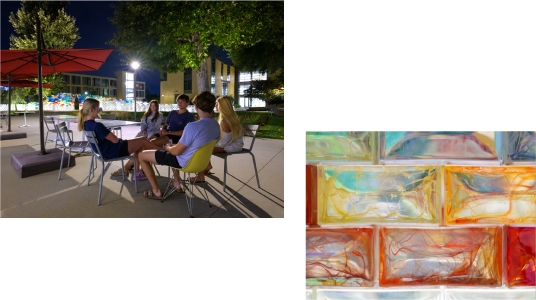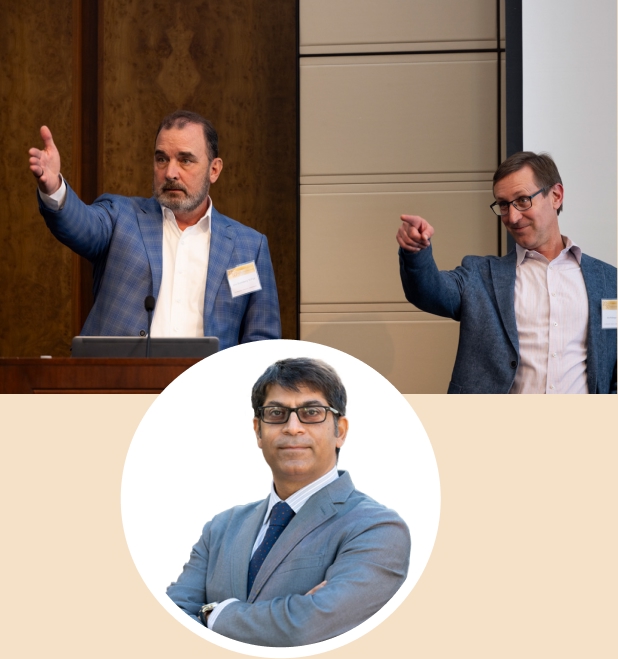Photos by Anibal Ortiz, Watchara Phomicinda, and Isaiah Tulanda ’20
Introducing...Qwalala
Of all the Public Art Program additions that have been made to CMC’s campus since 2015, Qwalala can certainly claim to be the most colorful. It simultaneously feels like the most magical.
Located in the Mid-Quad area just south of Collins Dining Hall, Qwalala stands nearly eight feet at its highest point and is 250 feet long. The massive piece from Los Angeles-based artist Pae White features two archways and is made up of more than 1,500 glass bricks—each weighing nearly 40 pounds and hand-forged by Italian artisans—in a palette of 26 colors.
The title of the work, Qwalala, is derived from the Pomo tribal word describing the path of the Gualala River on the northern coast of California. Like the river itself, Qwalala changes throughout the day and evening as light and shadows cast upon the clear and colored glass bricks. Qwalala’s special illumination in the evening—until midnight—also allows it to take on an entirely new appearance and dimension thanks to the swirling colors of the bricks activated by the light.
“If you look away for two minutes, you look back, it’s going to be different,” said White, a 1985 Scripps College alumna. “So, to have that kind of ever-evolving aspect of the piece, it’s just a dream.”
Kimberly Shiring, Secretary of the College and Director of Public Art, said Qwalala has “activated a social space to inspire, to challenge, to bring wonder, and to engage with each other constructively.” Its interactive design further “represents the fusion of art, culture, and nature,” added Devanshi Guglani ’25, Co-President of the CMC Student Art Council. “It is a testament to the ingenuity of artist Pae White and has completely revitalized our Mid-Quad space.”
clay bricks, walls high cold
world’s centrifuge spits us out
to choose sides, blind eyes
warm sun through glass, we
pass through lines offense defense
I now see you, us
—original haiku by President Hiram Chodosh
Heard at The Ath
For the past four decades, the Marian Miner Cook Athenaeum has served as the heart of intellectual and social engagement on Claremont McKenna’s campus, attracting prestigious speakers and shining a light on the College as a hub for thoughtful and constructive dialogue. Here are highlights from speakers this academic year.
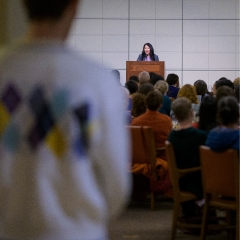
“I would like to express my gratitude … to everyone who is willing to risk a little vulnerability to be in a room where poems are being read, because sometimes we have to open our hearts in ways that we are not always ready for.”
– U.S. Poet Laureate Ada Limón, the first Latina to serve as the nation’s official poet. She has been honored with both a Guggenheim and a MacArthur “Genius” Fellowship.
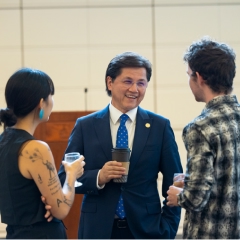
“Over the years, I’ve had the opportunity to meet with presidents, prime ministers, ambassadors, and legislators to pass laws. But taking in the big picture, despite those accomplishments, I have been frustrated by the lack of action for those who could make a difference in people’s lives. I often remind myself of those words of the late Senator John McCain, that hope is a powerful defense against oppression.”
– Nury Turkel, Commissioner at the U.S. Commission on International Religious Freedom and author of No Escape: The True Story of China’s Genocide of the Uyghurs.
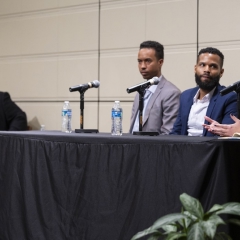
“Systemic racism doesn’t necessarily do a good job of helping us to make sense of things. Instead of trying to understand why it is that there are inequalities between so-called racial groups, we need to historicize whatever policy, issue, or question that we’re interested in, and understand all of the parts of that whole. And then from there, try to think about how we might fashion some type of policy or procedure that could potentially address some of those inequalities.”
– Jared Clemons, Temple University Assistant Professor of Political Science, who has an extensive research background spanning political economy, race, and the politics of education.
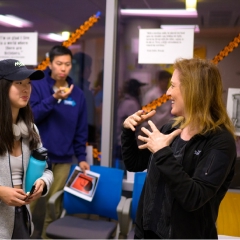
“I’m intrigued by the relationship between our internal human rhythms and the natural environment. Whether it’s our beating hearts, our breath patterns, or the electrical waves of our brain.”
– Linda Alterwitz, who has created art transposing diagnostic medical images, including patterns generated by EKGs, EEGs, and functional MRIs, onto landscape and other images.
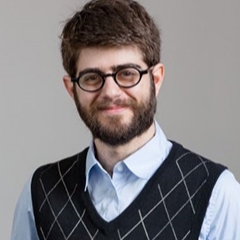
“The Athenaeum has long been a space of communal gathering at CMC, and we love to have musical performances for the holidays. That’s why the Ath is the perfect place to continue this wonderful tradition. As a student of Ward’s, it was an honor to bring Singing Parties to the Ath, and I hope that there will be many more to come!”
– Brian Davidson ’08, Interim Director of the Ath, on the thrill of bringing the Singing Party back to CMC in honor of the late Ward Elliott, a beloved professor and mentor.
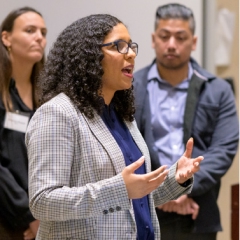
“When I was in school, I was so intimidated by (the Ath) and its extraordinary speakers that I never asked a single question at Q&A. I also never had the pleasure of sitting at the head table before. But I did last night and was graced by the presence of current students who I am sure are going to change this country for the better.”
– Candace Valenzuela ’06, reflecting on “the awe” of being asked to return as an Ath speaker. Valenzuela is the U.S. Department of Housing and Urban Development’s Regional Administrator in the Southwest.
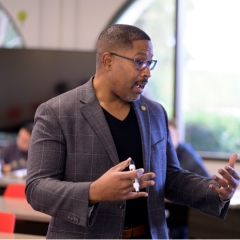
“When we look at ethics and the environment, we look broadly at it, to try and find an exemplar of that. And that’s where Martin Luther King comes in. Often, we try to think of King only as this pivotal figure, this long glow and afterglow of 1963, the March on Washington. And yet, do we really engage the thinking of King?”
– Corey D. B. Walker, the Ath’s annual MLK commemorative speaker and Dean of Wake Forest University’s School of Divinity.
Investing in Student Success
Zara Vakath ’24 remembers the thrill of watching Super Micro Computer stock skyrocket more than 1,000 percent after an initial investment through CMC’s Student Investment Fund (SIF).
“None of us predicted this kind of return,” said Vakath, CEO of SIF, which is celebrating its golden anniversary this year. “This was way beyond our expectations.”
Operated exclusively by a team of CMC student portfolio managers and analysts, SIF was launched in 1974 with a $500 securities investment from a CMC alumnus. In 2015, CMC Trustee George R. Roberts ’66 P’93 made a leadership gift to amplify the impact of the fund. Today, the fund is now worth approximately $3 million.
Over the past 50 years, hundreds of CMCers have learned fundamental investing, developed long-term strategies for portfolio management, expanded organizational resources, and recruited and placed human capital within the fund. The work highlights how students fulfill CMC’s mission to prepare students for thoughtful and productive lives and responsible leadership in business, government, and the professions.
After joining the fund as a first-year CMCer, Vakath said investing quickly became her passion. It even shifted her career goals to finance. She completed an internship at Citadel, an investment firm in New York City, and will start a full-time job at the firm after graduating in May.
“Initially, I didn’t think I would pursue finance,” Vakath said. “I had a misconception that finance is quantitative and all math. But when you think about fundamental investing, which is what we do at SIF, it’s really about the qualitative piece just as much as it is about the quantitative piece. You’re doing critical thinking. You’re trying to assess factors that are sometimes more subjective.”
SIF students also look at macroeconomic trends, consumer sentiment, and perhaps most importantly, a company’s story—all of which are key to choosing investments. The group selects 10 to 15 student members a year. The Claremont Investment Management Company executes SIF trades and takes on an oversight role—ultimately, the entire portfolio is managed by students.
SIF members meet several times a week, pitching stocks and voting on where the fund will invest. With stock pitching an essential component to being a member of SIF, the fund actively recruits students who are passionate, creative, and not afraid to defend their idea when somebody challenges them on it, said Economics and Finance Professor Eric Hughson, who serves as SIF’s faculty advisor.
“The professionalization of the Student Investment Fund is so impressive,” said Hughson. “Students get internships in finance so much earlier in their careers than they used to, and exposure to finance early on is key. It’s really nice to see continued involvement from alumni who were formerly in the fund—the SIF has a network and they use it to get students access to internships.”
That was the case for Nick Lillie ’17, who currently works at a Series B technology company as chief financial officer after stints at Evercore and True Wind Capital. He returned recently to CMC to speak with SIF students about his post-graduation experience.
“SIF stands as the cornerstone of my career trajectory,” Lillie said. “It opened doors to unexplored career paths, equipped me with essential skills, and expanded my professional network. I’ve relied on SIF-learned skills at every turn.”
– Gilien Silsby
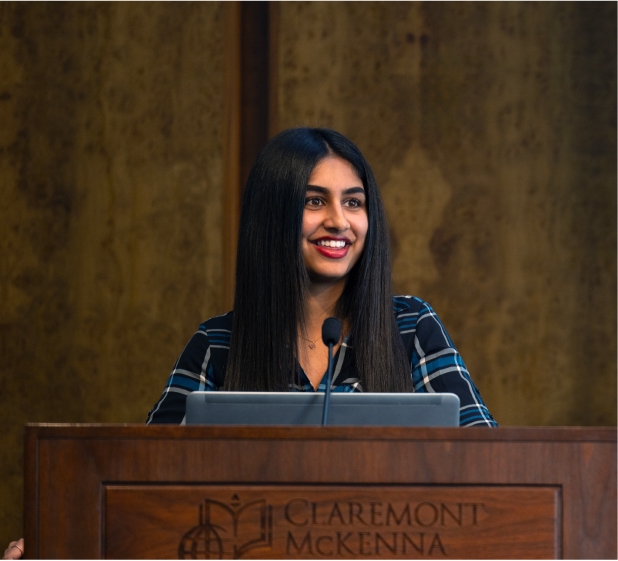
FEI Celebrates 20 Years
CMC’s Financial Economics Institute (FEI) is celebrating two decades of providing opportunities for students interested in finance. FEI’s hallmarks: Developing research skills, engaging with practitioners working in the world of finance, and offering students a rigorous emphasis on quantitative orientation.
“I feel honored to carry the mission forward as the director of FEI. Of course, the nature of the finance industry has changed a lot over the past two decades, and I want to make sure FEI adapts and evolves in serving our students appropriately—preparing them for the future of finance,” said Nishant Dass, Director of FEI and the Charles M. Stone Professor of Finance.
FEI Advisory Board Chairs—Alan Heuberger ’96 and John Shrewsberry ’87 P’24—recently returned to campus for a combined FEI and Student Investment Fund anniversary celebration. They emphasized the long-term impact of FEI and how CMC students are learning vital, practical skills as they work on their institute projects.
“FEI is a stalwart among the research institutes here at CMC,” said Shrewsberry, a CMC Board of Trustee member. “The work that students are doing with FEI will certainly send them into the workforce with real skills. My advice to students is to absorb all of the benefits of your work and position yourselves for whatever jobs or academic careers that you are truly passionate about.”
